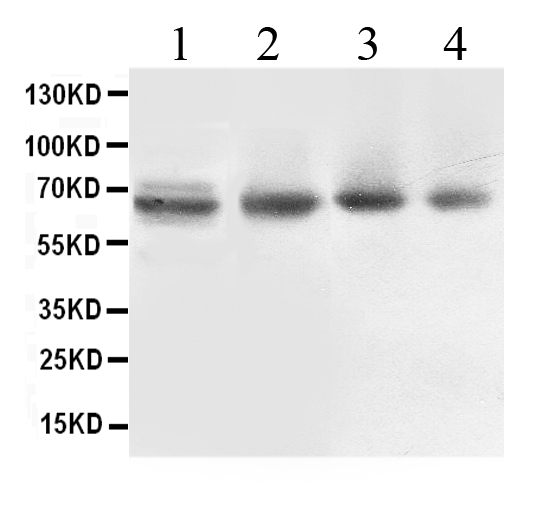Anti-ABCB10 Picoband Antibody
- SPECIFICATION
- CITATIONS
- PROTOCOLS
- BACKGROUND

Application
| WB |
|---|---|
| Primary Accession | Q9NRK6 |
| Host | Rabbit |
| Reactivity | Human, Rat |
| Clonality | Polyclonal |
| Format | Lyophilized |
| Description | Rabbit IgG polyclonal antibody for ATP-binding cassette sub-family B member 10, mitochondrial(ABCB10) detection. Tested with WB in Human;Rat. |
| Reconstitution | Add 0.2ml of distilled water will yield a concentration of 500ug/ml. |
| Gene ID | 23456 |
|---|---|
| Other Names | ATP-binding cassette sub-family B member 10, mitochondrial, ATP-binding cassette transporter 10, ABC transporter 10 protein, Mitochondrial ATP-binding cassette 2, M-ABC2, ABCB10 |
| Calculated MW | 79148 MW KDa |
| Application Details | Western blot, 0.1-0.5 µg/ml, Human, Rat |
| Subcellular Localization | Mitochondrion inner membrane; Multi-pass membrane protein. |
| Tissue Specificity | Ubiquitous. Highly expressed in bone marrow, expressed at intermediate to high levels in skeletal muscle, small intestine, thyroid, heart, brain, placenta, liver, pancreas, prostate, testis, ovary, leukocyte, stomach, spinal cord, lymph node, trachea and adrenal gland, and low levels are found in lung, kidney, spleen, thymus and colon. |
| Protein Name | ATP-binding cassette sub-family B member 10, mitochondrial |
| Contents | Each vial contains 5mg BSA, 0.9mg NaCl, 0.2mg Na2HPO4, 0.05mg NaN3. |
| Immunogen | A synthetic peptide corresponding to a sequence at the C-terminus of human ABCB10 (640-678aa QRIAIARALLKNPKILLLDEATSALDAENEYLVQEALDR), different from the related mouse sequence by one amino acid. |
| Purification | Immunogen affinity purified. |
| Cross Reactivity | No cross reactivity with other proteins |
| Storage | At -20˚C for one year. After r˚Constitution, at 4˚C for one month. It˚Can also be aliquotted and stored frozen at -20˚C for a longer time.Avoid repeated freezing and thawing. |
| Name | ABCB10 (HGNC:41) |
|---|---|
| Function | ATP-dependent transporter located in the mitochondrial inner membrane that catalyzes the export of biliverdin from the mitochondrial matrix, and plays a crucial role in hemoglobin synthesis and antioxidative stress (PubMed:22085049, PubMed:28315685, PubMed:28808058, PubMed:34011630, PubMed:37041204). Participates in the early step of the heme biosynthetic process during insertion of iron into protoporphyrin IX (PPIX) (PubMed:22085049, PubMed:28808058). Involved in the stabilization of the iron transporter mitoferrin- 1/SLC25A37 (By similarity). In addition may be involved in mitochondrial unfolded protein response (UPRmt) signaling pathway, although ABCB10 probably does not participate in peptide export from mitochondria (PubMed:28315685). |
| Cellular Location | Mitochondrion inner membrane {ECO:0000250|UniProtKB:Q9JI39}; Multi-pass membrane protein |
| Tissue Location | Ubiquitous. Highly expressed in bone marrow, expressed at intermediate to high levels in skeletal muscle, small intestine, thyroid, heart, brain, placenta, liver, pancreas, prostate, testis, ovary, leukocyte, stomach, spinal cord, lymph node, trachea and adrenal gland, and low levels are found in lung, kidney, spleen, thymus and colon. |

Thousands of laboratories across the world have published research that depended on the performance of antibodies from Abcepta to advance their research. Check out links to articles that cite our products in major peer-reviewed journals, organized by research category.
info@abcepta.com, and receive a free "I Love Antibodies" mug.
Provided below are standard protocols that you may find useful for product applications.
Background
ABCB10, also known as M-ABC2, is expressed as a 60-kD nonglycosylated mitochondrial membrane protein. This ABCB10 gene is mapped to 1q42.13. The membrane-associated protein encoded by this gene is a member of the superfamily of ATP-binding cassette (ABC) transporters. ABC proteins transport various molecules across extra- and intra-cellular membranes. And ABC genes are divided into seven distinct subfamilies (ABC1, MDR/TAP, MRP, ALD, OABP, GCN20, White). This protein is a member of the MDR/TAP subfamily. Members of the MDR/TAP subfamily are involved in multidrug resistance. The function of this mitochondrial protein is unknown.
If you have used an Abcepta product and would like to share how it has performed, please click on the "Submit Review" button and provide the requested information. Our staff will examine and post your review and contact you if needed.
If you have any additional inquiries please email technical services at tech@abcepta.com.













 Foundational characteristics of cancer include proliferation, angiogenesis, migration, evasion of apoptosis, and cellular immortality. Find key markers for these cellular processes and antibodies to detect them.
Foundational characteristics of cancer include proliferation, angiogenesis, migration, evasion of apoptosis, and cellular immortality. Find key markers for these cellular processes and antibodies to detect them. The SUMOplot™ Analysis Program predicts and scores sumoylation sites in your protein. SUMOylation is a post-translational modification involved in various cellular processes, such as nuclear-cytosolic transport, transcriptional regulation, apoptosis, protein stability, response to stress, and progression through the cell cycle.
The SUMOplot™ Analysis Program predicts and scores sumoylation sites in your protein. SUMOylation is a post-translational modification involved in various cellular processes, such as nuclear-cytosolic transport, transcriptional regulation, apoptosis, protein stability, response to stress, and progression through the cell cycle. The Autophagy Receptor Motif Plotter predicts and scores autophagy receptor binding sites in your protein. Identifying proteins connected to this pathway is critical to understanding the role of autophagy in physiological as well as pathological processes such as development, differentiation, neurodegenerative diseases, stress, infection, and cancer.
The Autophagy Receptor Motif Plotter predicts and scores autophagy receptor binding sites in your protein. Identifying proteins connected to this pathway is critical to understanding the role of autophagy in physiological as well as pathological processes such as development, differentiation, neurodegenerative diseases, stress, infection, and cancer.


